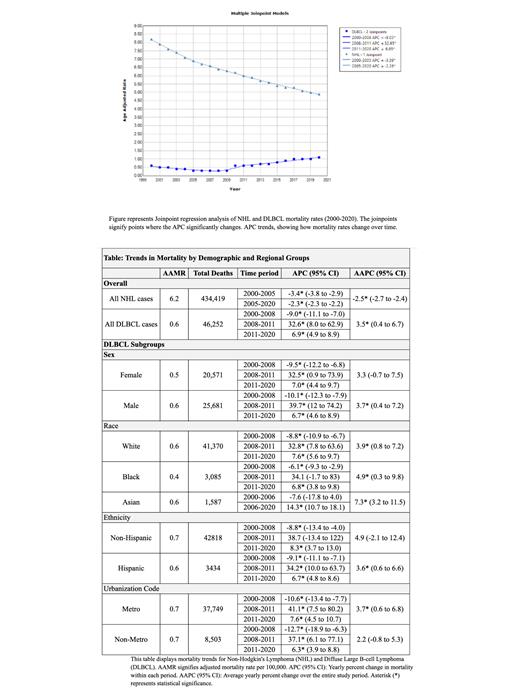Introduction:
Diffuse large B-cell lymphoma (DLBCL) is the most common subtype of Non-Hodgkin Lymphoma (NHL), accounting for approximately 30% of all cases. While NHL mortality rates have shown a downward trend over the last two decades, comprehensive investigations into DLBCL mortality trends and disparities across racial, ethnic, gender, and geographical categories in the United States are notably scarce.
Methods:
Utilizing the Centers for Disease Control and Prevention's (CDC) WONDER database we identified all patients who died from NHL and DLBCL from 2000 to 2020. Age-adjusted mortality rates per 100,000 persons (AAMR) were calculated and standardized to the 2000 US census data. The National Cancer Institute (NCI) Joinpoint Regression Program was used to analyze these data to calculate annual percent changes (APCs) and average annual percent changes (AAPCs). Statistically significant changes were confirmed when the confidence interval for the APC or AAPC did not encompass zero. Additionally, subgroup analyses were conducted based on race, ethnicity, gender, and geographic location.
Results:
The study identified 434,419 NHL and 46,252 DLBCL deaths. NHL mortality showed a statistically significant average annual decrease of 2.5% (95% CI: -2.7 to -2.4). DLBCL mortality trends varied, initially decreasing from 2000 to 2008, then notably increasing from 2008 to 2011, and subsequently rising moderately from 2011 to 2020. This pattern culminated in a statistically significant overall average annual increase of 3.5% (95% CI: 0.4 to 6.7) in DLBCL mortality. Subgroup analyses revealed that males, Blacks, and Asians or Pacific Islanders experienced the most marked upward trends in DLBCL mortality. Both metropolitan and non-metropolitan areas reported an increase in DLBCL mortality, with metropolitan areas showing a more pronounced rise.
Conclusion:
Representing the most comprehensive analysis of DLBCL mortality trends to date, our study revealed intriguing disparities among the subgroups we investigated, along with an upward trend in mortality rates that departs from previously reported data. The divergence could be attributed, in part, to the expansive population coverage of the database we utilized and the use of death certificates, which may present discrepant results from other cancer registries. These findings underscore the necessity for ongoing research, guiding the development of targeted intervention strategies for DLBCL and informing efforts to bridge the identified disparities.
Disclosures
No relevant conflicts of interest to declare.


This feature is available to Subscribers Only
Sign In or Create an Account Close Modal